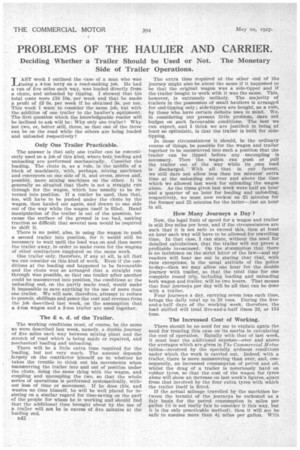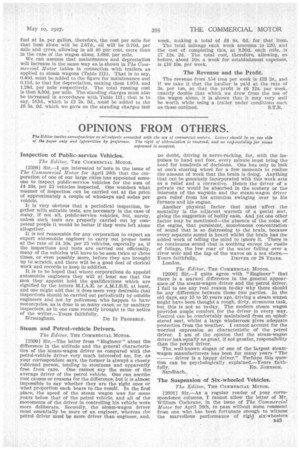PROBLEMS OF THE HAULIER AND CARRIER.
Page 68

Page 69

If you've noticed an error in this article please click here to report it so we can fix it.
Deciding Whether a Trailer Should be Used or Not. The Monetary Side of Trailer Operations.
LAST week I outlined the case of a man who was _L./using a 4-ton lorry on a road-making job. He had a run of five miles each way, was loaded directly from a chute, and unloaded by tipping. I showed that his total costs were £16 10s. per week and that he niado a profit of £3 Os. per week if he obtained 3s. per ton: krhis week I want to consider the same job, but with the addition of one trailer to the haulier's equipment. The first question which the knowledgeable reader will be inclined to ask will be: Wily only one trailer? Why 'lot two, or, better still, three, so that one of the three can be on the road while the others are being loaded and unloaded respectively?
Only One Trailer Practicable.
The answer is that only one trailer can be conveniently used on a job of this kind, where both loading and unloading are performed mechanically. Consider the loading. The chute is, as a rule, in the middle of a block of machinery, with, perhaps, mixing machines and conveyors on one side of it, and ovens, stoves and, possibly, more mixing machines on the other. It is generally so situated that there is not a straight run through for the wagon, which has usually to be reversed into position. If a trailer be used, then that, too, will have to be pushed under the chute by the wagon, then hauled out again, and drawn to one side out of the way while the wagon itself is filled. Hand manipulation of the trailer is out of the question, because the surface of the ground is too bad, making traction so difficult that several men would be required to shift it.
There is no point, also, in using the wagon' to push a second trailer into position, for it would still be necessary to wait until the load was on and then move the trailer away, in order to make room for the wagons of other contractors employed on the same work.
One trailer only, therefore, if any at all, is all that We can consider on this kind of work. Even if the conditions at the loading end happened to be favourable and the chute was SG arranged that a straight run through was possible, so that one trailer after another could be inameuvred into position, the conditions at the unloading end, on the partly made road, would make It impossible to save anything by the use of more than one trailer. We will now, therefore, attempt to reduce to pounds, shillings and pence the cost and revenue from the job described last week, on the assumption that a 4-ton wagon and a 3-ton trailer are used together.
The £ s. d. of the Trailer.
The working conditions must, of course, be the same as were described last week, namely, a double journey of five miles each way between mixing plant and the stretch of road which is being made or repaired, and mechanical loading and unloading.
There will be a little extra time required for the loading, but not very much. The amount depends largely on the contractor himself as to whether he takes the trouble to think out his movements when manceuvring the trailer into and out of position under the chute, doing the same thing with the wagon, and coupling and uncoupling the two, so that the whole series of operations is performed systematically, without loss of time or movement. If he does this, and wastes no time himself, he will be well placed for insisting on a similar regard for time-saving on the part of the people for whom he is working and should find that the additional time brought about by the use of a trailer will not be in excess of five minutes at the loading end.
B42 The extra time required at the other end of the journey might also be about the same if it happened to be that the original wagon was a side-tipper and if the trailer bought to work with it was the same. This, however, is extremely unlikely. The majority of trailers in the possession of small hauliers is arranged for end-tipping only ; side-tippers are bought, as a rule, by thotse who have certain definite uses in mind. We, in considering our present little problem, dare not budget on such favourable conditions. The best we can expect; and I think we are justified in being at least so optimistic, is that the trailer is built for sidetipping.
In those circumstances it should, in the ordinary course of things, be possible for the wagon and trailer together to be manceuvred into such a position that the -trailer can be tipped before any uncoupling is necesary. Then the wagon can push or pull the trailer out of the way while its ,own load is discharged. " With all that in our favour, we still dare not allow less than ten minutes' extra time at the unloading end over and above the time which we allowed last week for unloading the wagon alone. As the times given last week were half an hour and a quarter of an hour for loading and unloading, respectively, we must now reckonon 35 minutes for the former and 25 minutes for the latter—just an hour in all.
How Many Journeys a Day ?
Now, the legal limit of speed for a wagon and trailer is still five miles per hour, and if the circumstances are such that it is not safe to exceed this, then at least an hour each way will have to be allowed, for travelling time. In that case, I can slate, without the need for detailed calculations, that the trailer will not prove a profitable investment. On the a‘isumption that there is no insistence on the strict letter of the law—and my readers will bear me out in stating that that, with rare exceptions, is the usual attitude of the police to-day—then we may allow one hour for the double journey with trailer, so that the total time for one complete round trip, including loading and unloading both wagon and trailer, will be two hours. That means that four journeys per day will be all that can be done with a trailer.
Four journeys a day, carrying seven tons each time, brings the daily total up to 28 tons. During the fiveand-a half days of the working week, therefore, the load shifted will total five-and-a-half times 28, or 154 tons.
The increased Cost Of Working.
There should he no need for me to explain again the need for treating this case on its merits in calculating the cost of operation. Equally with that of last week, it must bear the additional expense—over and above the averages which are given in The Commercial Motor tables—involved by the specially arduous conditions under which the work is carried out. Indeed, with a trailer, there is more manceuvring than ever, and, consequently, an increased consumption of petrol and oil, whilst the drag of a trailer is notoriously hard on rubber tyres, so that the cost of the wagon for tyres alone will show an increase on last week's figures, apart from that involved by the four extra tyres with which the trailer itself is fitted.
If the actual mileage travelled by the machines between the termini of the journeys be reckoned as a fair basis for the petrol consumption in miles per gallon (it is not really fair to consider it this way, but it is the only practicable method), then it will not be safe to assume more than ft miles per gallon. With fuel at ls, per gallon, therefore, the cost per mile for that item alone will be 2.67d., oil will be 0.70d. per mile and tyres, allowing in all 40 per cent, more than in the case of the wagon alone, 1.68d. per mile.
We can assume that maintenance and depreciation will increase in the same way as is shown in The Commercial Motor tables in connection with trailers as applied to steam wagons (Table III). That is to say, 0.40d. must he Added to the figure for maintenance and 0.11d. to that for depreciation, making them 1.97d. and 1.28d. per mile respectively. The total running cost is then 8.30d. per mile. The standing charges must also be increased in accordance with Table III; that is to say, 513d., which is 12 2s. od.., must be added to the 16 5s. 9d. which we gave as the standing charges last
week, making a total a £8 8s. 6d. for that item.
The total mileage each week amounts to 220, and the cost of completing this, at 8.30d. each mile,, is 17 12s. 2d. The total cost, therefore, allowing, as before, about 10s. a week for establishment expenses, is £16 10s. per week.
The Revenue and the Profit.
The revenue from 154 tons per week is £23 2s., and if we take it that the haulier is paid at the rate of 3s. per ton, so that the profit is £6 12s. per week, exactly double that which we drew from the use of the wagon alone, it is shown that it may very well be worth white using a trailer under conditions such
as those outlined. S.T.R.




















































































































